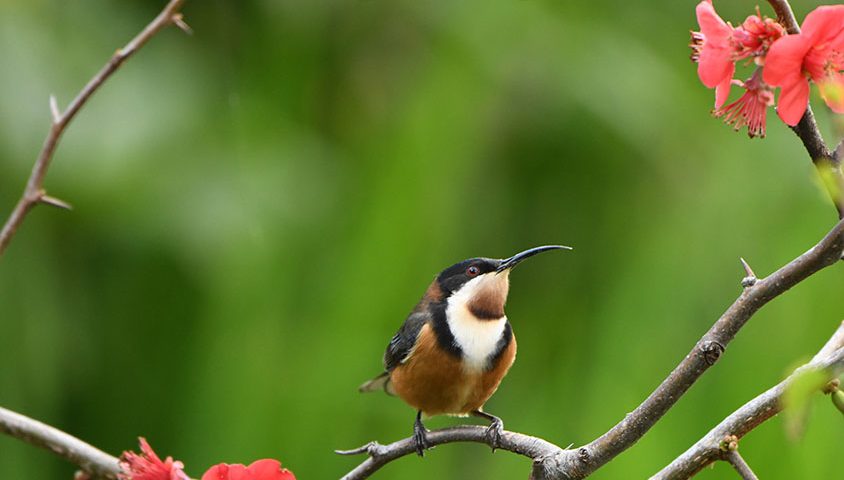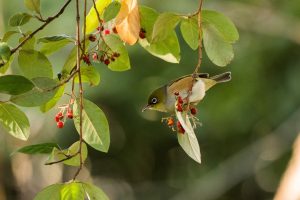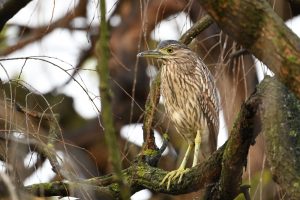Step out of the thunderous traffic and into a grove of giant evergreen oaks.
Here, the dappled light filters down to beds of artist’s acanthus alongside other shiny exotic beauties. Through the foliage, a brick mansion stands regal. The building is reminiscent of a 19th Century estate in southern Europe – an impression reinforced when the path ahead is crossed by a blur of black feathers and an orange beak. It’s July, so where are the sweet notes of the nightingale? The airwaves here speak not of summer’s African warbler and flycatcher migrants, but of birds escaping the chilly hills to ride-out winter on the coastal plain. This paradoxical garden says “pip… pip pip pipipipipipipi, yak-ah-yak”, “tzz tzzzz tzzz” and “birip beep beep”. And what sent that European blackbird hurtling so frantically over the path before? A big, female collared sparrowhawk – one of Australia’s fiercest bird-hunters.
Upon entering Rippon Lea Estate on the 15th of July 2017, I heard the call of an eastern spinebill, then a second and a third. In five years of surveying wildlife at the nearby Elster Creek and Elwood Canal I have personally seen 140 bird species, but never an eastern spinebill.
So I walked and counted for an hour and the astounding picture became clearer with 15 brown thornbills, 13 silvereyes, two spotted pardalotes and two grey fantails. This list represents some of south-east Australia’s most common and characteristic ‘bush-birds’, but at the same time they are all species that have been dramatically dropping out of the urban landscape in recent years. To find them in such a healthy state at Rippon Lea filled me with joy and presented a learning opportunity.
A noisy, native problem
The Rippon Lea Estate is in the care of the National Trust which is “working towards conserving and protecting our heritage for future generations to enjoy”. So despite my great surprise at the natural riches of this historic garden, the fact that it is also inadvertently conserving our pre-historic heritage seems fitting. The puzzle is that, of our various inland parks, why should the one to host the most intact community of indigenous birds also be the one most totally devoid of indigenous plants? These birds have evolved to suit the native forests and heaths of south-eastern Australia. Why do they shun most of our parks which are fairly well adorned with indigenous plants?
The stretch of Elster Creek running between Foam and Wave Streets in Elwood, for example, has been the focus of revegetation efforts for decades. In it grows a complex indigenous plant community providing wholesome structure from the ground up. It looks like a great success of habitat creation, but once again, as on entering the Rippon Lea gardens, the ears quickly tell us what our eyes don’t. You will not hear the calls of the brown thornbill, silvereye, eastern spinebill or grey fantail here (at least, I have not in five years). This is a soundscape almost totally dominated by just one species – the noisy miner – and the same is now true for all other large, green spaces in the region – except for the coastal scrubs and Rippon Lea Estate.
Not to be confused with the introduced common myna, the noisy miner is a native honeyeater. In fact, it is about as Australian as they come. Ecologist Tim Low remarked “A reading of recent research shows that Australian birds are more likely than most to eat sweet foods, live in complex societies, lead long lives, attack other birds and be intelligent and loud”. The noisy miner fits these criteria to a higher degree than perhaps any other bird (although it’s relative the bell miner is a close contender). Perhaps they would be more accurately described as noisy farmers, for their favourite food is both harvested and protected with the upmost diligence so as to ensure a prolific and regenerating crop.
If the birds are farmers, then their crop is lerp (tiny white caps, made mostly of sugars, which often appear on Eucalyptus leaves) and their livestock are psyllids (sap-sucking insects that create the lerp from waste products and live under it for shelter). Both the psyllids and their lerp creations are relished as food by a great multitude of birds, but the miners are unique in that they will carefully peel away the lerp without taking the insect underneath. The psyllid is therefore left to live another day and build another lerp.
It is of no use however, to cultivate a reliable resource if other competitor-species are going to reap the rewards, so noisy miners combine their gentle harvest with cooperation among their fellows and a hyper level of aggression toward other species which is unparalleled in the bird world. Birds of all sizes are mobbed relentlessly and smaller birds such as pardalotes are often killed. As for their noisy namesake; these birds vocalise almost continually from dawn to dusk. They are communicating between members of the colony, but also projecting a wall of sound around their territory – a warning which most birds from fairywrens to falcons tend to heed. At times, the lerp farms can be so prolific in the absence of insectivorous birds that the host trees die en masse and the whole ecosystem crumbles. That is an immense ecological influence for just one bird species and it is this unique ability that has earned it the seldom-used label of a ‘reverse keystone species’. That is to say that the arrival of this bird in an ecosystem is akin to removing the keystone from an arch. One study found that as noisy miner population density increased from zero per hectare to 0.6 per hectare, the number of species of small bush birds halved.
Feathered colonists
At the beginning of European settlement in Melbourne, noisy miner colonies were probably quite uncommon and patchily distributed in a few pockets of suitable habitat along the lower Yarra River where they could hold fort against intruders. These pockets would have been characterised by scattered open eucalypt canopies and short grass, grazed by kangaroos, with minimal cluttered vegetation in between. While the mobs of grazing roos have been replaced by the lawn mower, urban parks and golf courses mimic this habitat-type closely enough in the eyes of noisy miners so as to invite the colonisation of vast new lands. One of their earliest nearby outposts was Braeside Park in the 1970s. From there they hopped, park to park, decimating bird communities as they went. They were first reported in St Kilda in the late 1980s when Geoff Price noticed a few in the eucalypts behind the St Kilda Library.
Over the following years they invaded every suitable patch in the region, increasing in number until plateauing around the mid-2000s. It was at this time of expansion that the abundant white-plumed honeyeaters vanished from the St Kilda Botanical Gardens, never to be seen again (they were relegated to odd places like public carparks where there are just enough eucalypts for their needs but not enough for a miner colony) and the little falcons, which would nest each year atop a Canary Island pine, raised their last offspring. Yellow-rumped thornbills could no-longer be found at their usual haunts in the Elsternwick Golf Course and Albert Park (this species is now locally extinct in both municipalities of Bayside and Port Phillip) and the spring arrival of the sacred kingfishers became a rare sight.
I was lucky enough to see a sacred kingfisher briefly in the St Kilda Botanical Gardens in October 2012. The next morning, I slung an iPod and speaker in a tree and broadcasted the kingfisher’s call. Scarcely ten seconds had elapsed while waiting for a real kingfisher’s reply when the speaker was engulfed by an angry hoard of noisy miners. It seems likely that the spread of the noisy miner has had a greater impact on indigenous bird communities than have all introduced birds combined. You could say that the noisy miner is pardalote enemy number one. But it is important to remember that their unnatural proliferation in Melbourne is a symptom of our own unnatural activities over the last two centuries..
The Rippon Lea Estate offers none of the three habitat-features that noisy miners require:
- Abundant eucalypts
- Large expanses of short grass (less than five centimetres in length)
- An open or absent mid-story layer
For the above reasons, Rippon Lea retains healthy populations of some of the small bird species that have become less common in other parks in the last 15 years. When these small birds do occur in other nearby parks, they generally lie low in the dark, miner-free zones with ample cover such as the north-east corner of the St Kilda Botanical Gardens. Whereas at Rippon Lea, they are noticeably more brazen, often working the outer foliage or even the leafless deciduous trees.
I had previously considered the Royal Botanical Gardens Melbourne to be the best place to see eastern spinebills in Melbourne, but proportionately they seem to have a greater presence at Rippon Lea. The same is true for Nankeen night herons, which often roost in the open during the day around the estate’s lake. Grey fantails have never been recorded in the City of Port Phillip in August, but just over the Hotham Street municipal border they have apparently stayed through this winter. It is now eleven years since the last collared sparrowhawks nested in the City of Port Phillip at Alma Park, but recent observations suggest that they may be preparing to nest in Rippon Lea’s tallest Monterey cypress.
The trees around Rippon Lea’s lake also happen to support what is undoubtedly one of Melbourne and Port Phillip Bay’s largest little pied cormorant roosts. Observations made just over the last month already point to a special importance of the Rippon Lea Estate for local wintering birds. A more detailed picture of its benefit to broader biodiversity will emerge during the spring and autumn seasons of bird migration. I suspect that this garden will prove to be a welcome migration stepping-stone in an otherwise fairly hostile landscape, with likely visits by rose robin, pink robin, rufous fantail, golden whistler and sacred kingfisher (judging by the habitat present). It is also a living laboratory. Through it’s pronounced contrast with other parks, the Rippon Lea Estate is offering ecological insights that will inform better care and understanding of nature in the city.




